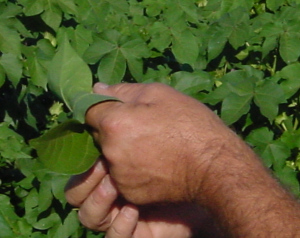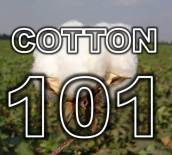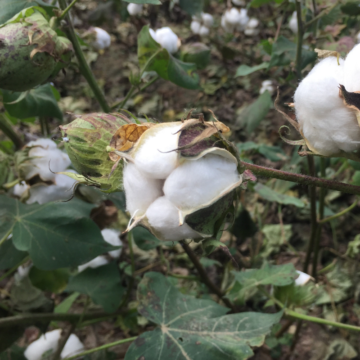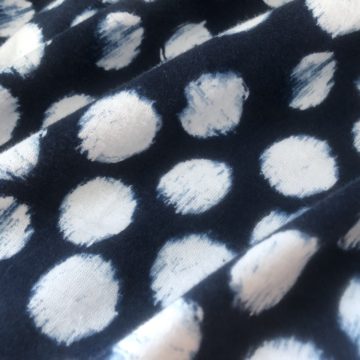Okay, big disclaimer here. I’m not a cotton expert nor a cotton farmer. I don’t mean to in anyway suggest which variety a given farmer should plant, but I thought some of the folks who don’t plant cotton varieties may be interested in some of the considerations cotton farmers have in selecting varieties to plant on their farm. So this is the sort of thing I’ve heard from farmers or experts. (Please weigh in if you are an expert!)
Yield potential — Its obviously what growers look for and it can depend on several agronomic factors including , disease or nematode tolerance, performance under various water scenarios (dryland, various types of irrigation), plant type (fruiting in a columnar pattern or bushy type), etc.

Maturity — The maturity of a variety is usually one of the first factors considered. The typical classifications are early, early-mid, mid, mid-full and full season. Areas in the northern parts of the Cotton Belt (the Missouri Bootheel, Tennessee, North Carolina, etc) tend to plant early season or early-mid varieties whereas areas like Arizona, South Texas and South Georgia tend to go for more full season varieties.
Unlike some crops, the way a crop is managed can result in a cotton variety fitting areas where it wasn’t considered to fit otherwise. This Cotton Maturity Chart for 2011 by the University of Tennessee provides growers the relative maturity of varieties to use in their variety selection process.
 Leaf Type — Cotton varieties can have smooth leaves, hairy leaves or semi-smooth. This is one of the things that seems automatic preference by farmers in different areas — typically Arizona farmers want smooth leaf where areas of the Rolling Plains of Texas may be more likely to plant a semi-smooth or hairy. And this is something that I find is hardest to explain to people. When you look at the underneath of a cotton leaf, it may be really smooth or look more hairy. There are a couple of things that go into leaf type preference — insect spectrum and whether they are attracted to the sugars generally available through leaf hair. Aphids are a sucking pest that could be more attracted to hairy plant types than smooth. On the other hand, some other pests may be warded off by hairy leaves. And the impact of leaf hair at harvest can mean impacts on fiber quality.
Leaf Type — Cotton varieties can have smooth leaves, hairy leaves or semi-smooth. This is one of the things that seems automatic preference by farmers in different areas — typically Arizona farmers want smooth leaf where areas of the Rolling Plains of Texas may be more likely to plant a semi-smooth or hairy. And this is something that I find is hardest to explain to people. When you look at the underneath of a cotton leaf, it may be really smooth or look more hairy. There are a couple of things that go into leaf type preference — insect spectrum and whether they are attracted to the sugars generally available through leaf hair. Aphids are a sucking pest that could be more attracted to hairy plant types than smooth. On the other hand, some other pests may be warded off by hairy leaves. And the impact of leaf hair at harvest can mean impacts on fiber quality.
Plant growth habit — Cotton plants can be determinant or indeterminant (and of course several degrees on that scale rather than simply one or another). Success with either largely rests on the environmental factors both for cut-out of determinant plants and fall weather conditions for indeterminant.
Technology — There are several choices for cotton farmers to consider depending on the pest pressure they have and the programs they want to undertake in controlling those pests. Choices include: conventional varieties (without biotech traits), biotech insect protection (there are choices in multiple traits with Monsanto’s Bollgard II and Dow’s WideStrike each offering two modes of lepidopteran protection) and biotech weed control through herbicide resistance (Monsanto’s Roundup Ready Flex as well as Bayer’s Liberty Link and GlyTol).
As I finished this up, I saw a resource I probably should have simply pulled info from. Its a bulletin on varietal characteristics from Oklahoma State University. Most of what I mention is in there, plus a lot more. Besides, its written by JC Banks and he’s one of the experts I have learned a lot from in the past mumble, mumble years.

While I have tried to be impartial with the above, I have to make sure you all know my preference is with Deltapine cotton varieties. 🙂 Great people there, with such incredible efforts in breeding so there are incredible product advancements and with the folks in the field helping position products… well, you can see why JPlovesDPcotton! LOL!
This is another post in my cotton 101 series on my blog. I started with harvest in 2010 and am excited about the 2011 season giving me lots of ideas for the series! You can click on the linked photo to get to the list of posts on the subject.





Great blog. I love learning more about other crops that I’m unfamiliar with. Thanks for taking the time to share your knowledge with me.
Great blog janice. I would like to point out one other major factor, how it hangs in and picks out of the burr. If cotton is to loose in the burr it is usually I high yielder but not very storm tolerant. In Mississippi we tend to get a lot of hurricanes during harvest season so we will plant cotton varieties that are loose in the burr first so we can get them out first hopefully before a storm hits. We plant varieties that hang in the burr tighter later because they will have to stay in the field longer and be exposed to more of the elements.
Also to help explain the leaf characteristics, harry leaf cotton is mostly thought of as tougher but more susceptible to certain insect species. Your smooth leaf cottons are more like your “Cadillac” varieties, on good ground they thrive but aren’t as tough in other situations. Sorry for the long post but just wanted to offer my $.10. (Adjusted for inflation.
Thanks! You are so right! Storm proofness is critical in the areas likely to have hurricanes as well as the High Plains due to the likelihood of wind & hail.
JP,
I am a former state cotton specialist from Texas A&M University and now I am a cotton development speciaiist for DowAgrosciences supporting the Phytogen brand in Texas. I saw where you referenced Dr. Banks. J.C. was a mentor and good friend of mine. I’m assuming you know he retired last year and moved to his log cabin near Creed, CO. I was curious as to where you are located. Thanks.
Robert
Hello and thanks for checking out my blog. I am in Memphis and have known JC for a very long time. Am thrilled (and was aware) he has retired. I met him first when I worked for Gibbs & Soell out of New York and continued to work with him on various projects while I was with Deltpine. I am still with Monsanto but not with a cotton-specific roll. Can’t leave the crop I have worked on for decades though so I have been putting more of it on my personal blog here. Have a great day!